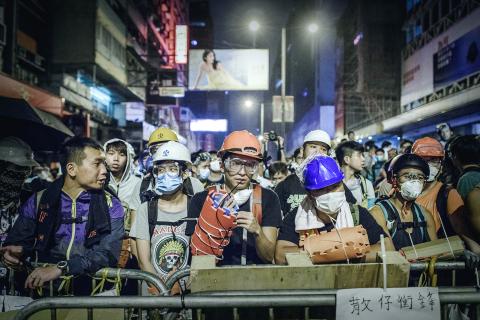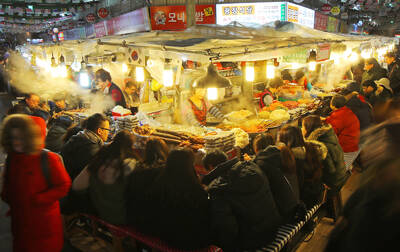When Anson Lau first joined Hong Kong’s pro-democracy rallies he carried little more than a raincoat and a bottle of water. But as police began wielding pepper spray and batons, the 20-year-old insurance agent has donned a hard hat and home-made body armor — symbols of a new and dangerous phase.
“When police began beating up people we had to put on defensive gear,” he told AFP standing at a makeshift barricade in the city’s densely packed Mongkok district, where the worst violence has broken out.
“We didn’t have helmets before. We had umbrellas. If the opposite side had left us alone, we wouldn’t have needed any of this,” he said, gesturing to his equipment.

Photo: AFP / Philippe Lopez
Lau’s experience is echoed by thousands of Hong Kong’s pro-democracy protesters who began their campaign for greater democracy in the former British colony with peaceful mass rallies, filled with optimism and praised for their civility.
But with the city’s Beijing-backed authorities showing no signs of budging on protesters’ core demands — and the embattled police, who had been noticeably restrained in the first two weeks of the protests, launching a series of recent dawn raids to try and clear barricades — a grim realism has set in.
Faces that once brimmed with enthusiasm have hardened, replaced by ranks of tired protesters steeling themselves for the next attempt by officers to push them off the streets.
Nowhere is this atmosphere more palpable than in the working class district of Mongkok. While the city’s two other protest sites across Victoria Harbor retain their carnival mood, Mongkok, in Kowloon, remains on edge.
Those manning the barricades there have borne the brunt of attacks by pro-government thugs and more recently police after they tried but ultimately failed to clear a camp that had dominated a busy intersection.
Au Yiu-kai was volunteering at a first aid station in Mongkok during the weekend clashes, and says he treated at least a dozen demonstrators, many of whom had angry wounds from police batons. “This is definitely not a low level of force,” he fumed. “That kind of force can be fatal.”
NEW AND DANGEROUS PHASE
Police, who also suffered injuries in the clashes, say the protesters in Mongkok form the spear tip of an increasingly radical and violent core, forcing them to respond in kind. During confrontations, the presence of volatile masked men taunting the police has become commonplace and officers accuse demonstrators of frequently charging their lines.
But protesters insist they have to suit up with whatever they can to defend themselves against new violent tactics from police.
Sociologist Chung Kim-wah, from Hong Kong Polytechnic University, says the protests have now entered a new and dangerous phase where both police and protesters are polarized, angry and more prone to violence.
“If it goes on, a more serious clash cannot be ruled out. If someone dies or gets seriously hurt, the damage would be huge for Hong Kong. The hatred would be difficult to extinguish,” he said.
The demonstrators say those in their ranks spoiling for the fight still do not represent a movement that has consistently pushed a non-violent message.
“We can only try our best to stay disciplined,” says Lau, talking about the hotheads who have goaded the police. “Most people are peaceful and restrained. And if someone gets emotional we will try to ask them to stop.”
Early Monday, for the first time in three nights, Mongkok was calm — largely thanks to two pro-democracy lawmakers who stood between police and protester lines until both sides took off their helmets.
Claudia Mo, one of those lawmakers, said many believed agitators were deliberately doing the government’s work.
“One can’t help having that suspicion,” she told AFP. “These provocateurs are very out of tune with the rest of crowd.”
“The more chaotic Hong Kong becomes the better for CY’s government and the more reason he has to clamp down,” she added, referring to the city’s China-backed leader Leung Chun-ying (梁振英).
Analysts say those dangers are made all the more acute by exhaustion and flagging morale among a stretched police service battling to maintain order with little concrete political resolution in sight.
Crunch talks between students and city leaders are expected Tuesday evening. But few of those on the barricades expect any results. “I’m seriously worried about tonight,” lawmaker Mo told AFP Tuesday.
“If this is just going to be a political show — where political animals form a political circus — people will think: ‘Well let’s just take to the streets again.’”
If talks do break down, people like Lau believe they will need to get their armour back out.
“Everyone of us needs to know how to protect ourselves and others,” he said, resignation etched on his tired face. “We have to adapt.”

In recent weeks the Trump Administration has been demanding that Taiwan transfer half of its chip manufacturing to the US. In an interview with NewsNation, US Secretary of Commerce Howard Lutnick said that the US would need 50 percent of domestic chip production to protect Taiwan. He stated, discussing Taiwan’s chip production: “My argument to them was, well, if you have 95 percent, how am I gonna get it to protect you? You’re going to put it on a plane? You’re going to put it on a boat?” The stench of the Trump Administration’s mafia-style notions of “protection” was strong

Every now and then, it’s nice to just point somewhere on a map and head out with no plan. In Taiwan, where convenience reigns, food options are plentiful and people are generally friendly and helpful, this type of trip is that much easier to pull off. One day last November, a spur-of-the-moment day hike in the hills of Chiayi County turned into a surprisingly memorable experience that impressed on me once again how fortunate we all are to call this island home. The scenery I walked through that day — a mix of forest and farms reaching up into the clouds

With one week left until election day, the drama is high in the race for the Chinese Nationalist Party (KMT) chair. The race is still potentially wide open between the three frontrunners. The most accurate poll is done by Apollo Survey & Research Co (艾普羅民調公司), which was conducted a week and a half ago with two-thirds of the respondents party members, who are the only ones eligible to vote. For details on the candidates, check the Oct. 4 edition of this column, “A look at the KMT chair candidates” on page 12. The popular frontrunner was 56-year-old Cheng Li-wun (鄭麗文)

“Eighteen years ago, people didn’t even know the name of this ingredient,” says 58-year-old Gil Sa-hyeon, holding up a cluster of dried brownish stems. “Now it’s everywhere.” His shop, Joseon Yakcho, sits in the heart of Seoul’s Yangnyeongsi Market, South Korea’s largest traditional medicinal herb market, its streets lined with shops displaying buckets of herbs such as licorice root and cinnamon bark that spill on to the pavements, filling the air with their distinct, earthy aroma. The ingredient Gil is referring to is hovenia dulcis, known in Korean as heotgae — the oriental raisin tree that’s become the cornerstone of South Korea’s